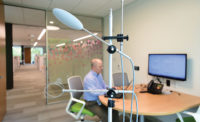A new report from a cloud service provider illustrates how the construction industry communicates.
“We thought the software industry would be highest in terms of mobility, but we were floored when we saw the trends of construction,” says Stephanie Hagio, a strategic project lead at Box Inc., Los Altos, Calif., a cloud content-management service.
Construction proved to be both the most mobile and the most externally collaborative of the five industries included in the study: software, media and entertainment, manufacturing, financial services and construction. Measuring communication data from 300 of its customers, Box monitored data-sharing devices, internal and external individual users, and their locations.
Of the 225,000 businesses that use its service, Box selected for the report 60 of its customers from each of the five industries.
Each company had between 100 and 1,000 employees, says Jonathan Evans, a strategic project lead at Box. “And they were using Box on a monthly basis,” he adds.
Whitney Bouck, Box general manager of enterprise, insists that, for the report, all data and company information was pulled anonymously, and only the behavior of sharing was tracked; further, all the companies agreed to take part in the study project.
“The software industry is building the mobile tools of the tomorrow. It’s not proving them out,” says Evans. “Most folks working in software are at their desk, coding. But construction relies on mobile devices in the field.”
The study visualizes decentralization of information, mobility, frequency of collaboration, content creation, consumption and external collaboration.
“Our visualizations aren’t just an artist’s rendering,” says Evans. When reading the graphs, it helps to think of each node as a planet, and the distance from one "planet" to another represents the "gravity" of any particular node's behavior (see graph). If a user is sharing a lot and connected with many people, the user's "gravitational pull" increases and the node becomes more centralized. The less sharing, the farther from center a node becomes. So blue nodes on the periphery of the graph represent external subcontractors that work only once or twice with cloud data.
Hagio says she hopes the study will help industries get a better view of their workflow compared to unrelated industries of similar size.










Post a comment to this article
Report Abusive Comment